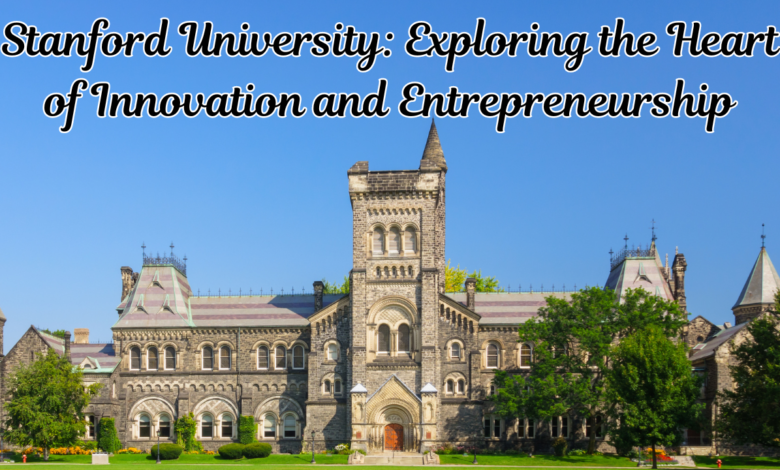Stanford University: Exploring the Heart of Innovation and Entrepreneurship

Introduction
Stanford University, founded in 1885 by Leland and Jane Stanford, is a beacon of innovation and entrepreneurship. Located in the heart of Silicon Valley in California, Stanford has played a pivotal role in the development of the technology industry and continues to foster a culture of creativity, collaboration, and cutting-edge research. This article delves into Stanford’s history, academic excellence, entrepreneurial ecosystem, notable programs, campus life, and global impact.
History and Legacy
Stanford University was established in memory of Leland Stanford Jr., the only child of the Stanfords, who died of typhoid fever at the age of 15. The university opened its doors in 1891 with a vision of providing practical education that would equip students to better society. From its inception, Stanford embraced coeducation and a non-sectarian approach, distinguishing itself from many contemporary institutions.
Early Years and Development
In its early years, Stanford University faced numerous challenges, including financial difficulties and the devastating earthquake of 1906. Despite these setbacks, the university’s commitment to academic excellence and innovation never wavered. Under the leadership of President David Starr Jordan, Stanford grew rapidly, establishing a strong foundation for its future development.
Modern Era
Today, Stanford University is a private research university with seven schools: Humanities and Sciences, Engineering, Earth, Energy & Environmental Sciences, Education, Business, Law, and Medicine. Its proximity to Silicon Valley has made it a catalyst for technological innovation and entrepreneurship, attracting talented students and faculty from around the world.
Academic Excellence
Stanford University is renowned for its rigorous academic programs, distinguished faculty, and a commitment to interdisciplinary research. The university offers a wide range of undergraduate, graduate, and professional degrees across various fields of study.
Undergraduate Education
Stanford’s undergraduate program emphasizes a liberal arts education that encourages students to explore diverse disciplines. The Stanford Undergraduate Program is designed to foster critical thinking, creativity, and intellectual curiosity. Students can choose from over 65 majors, ranging from humanities and social sciences to natural sciences and engineering.
Graduate and Professional Schools
Stanford’s graduate and professional schools are globally recognized for their excellence and innovation.
Stanford Graduate School of Business (GSB): Known for its MBA program, GSB emphasizes leadership, innovation, and entrepreneurship. The school’s experiential learning approach includes opportunities such as the Global Management Immersion Experience and the Stanford Venture Studio.
Stanford Law School: Offering a rigorous legal education, Stanford Law is renowned for its research and practical training opportunities. The school’s clinics and centers provide students with hands-on experience in various areas of law.
Stanford School of Engineering: A leader in engineering education and research, the school offers programs in fields such as computer science, electrical engineering, and bioengineering. Stanford Engineering’s focus on innovation and entrepreneurship is evident in its numerous research initiatives and partnerships with industry.
Entrepreneurial Ecosystem
Stanford University is at the heart of Silicon Valley, the world’s most dynamic hub for technology and innovation. The university’s entrepreneurial ecosystem is designed to support and nurture new ideas, startups, and technologies.
The Stanford Innovation Ecosystem
Stanford Technology Ventures Program (STVP): STVP is the entrepreneurship center at Stanford’s School of Engineering. It offers courses, resources, and events designed to inspire and educate the next generation of entrepreneurs.
StartX: An accelerator program for Stanford-affiliated entrepreneurs, StartX provides resources, mentorship, and funding opportunities. Many successful startups, such as Lime and Branch Metrics, have emerged from StartX.
The Stanford Center for Professional Development (SCPD): SCPD offers professional and executive education programs that connect Stanford’s cutting-edge research and teaching with industry leaders. These programs foster innovation and entrepreneurship among professionals.
Notable Startups and Alumni
Stanford has a long history of producing successful entrepreneurs and groundbreaking startups. Some notable companies founded by Stanford alumni include:
Google: Founded by Larry Page and Sergey Brin while they were PhD students at Stanford, Google has become one of the world’s leading technology companies.
Hewlett-Packard (HP): Bill Hewlett and Dave Packard, Stanford alumni, founded HP in a garage in Palo Alto, marking the beginning of Silicon Valley.
Instagram: Co-founded by Stanford alumni Kevin Systrom and Mike Krieger, Instagram has grown into one of the most popular social media platforms globally.
Notable Programs and Research Initiatives
Stanford University is home to numerous prestigious programs and research initiatives that contribute to its reputation as a leader in innovation and entrepreneurship.
Stanford Artificial Intelligence Laboratory (SAIL)
Founded in 1962, SAIL is one of the world’s leading AI research centers. The lab focuses on advancing AI through interdisciplinary research and collaboration. SAIL’s work has led to significant advancements in machine learning, robotics, and natural language processing.
Stanford Human-Centered Artificial Intelligence (HAI)
The Stanford HAI initiative aims to ensure that AI technologies benefit humanity. By combining expertise from various fields, including computer science, law, ethics, and social sciences, HAI addresses the broader implications of AI and promotes ethical development and deployment of AI technologies.
Stanford Woods Institute for the Environment
The Stanford Woods Institute focuses on interdisciplinary research to address global environmental challenges. By bringing together experts from different fields, the institute develops innovative solutions for issues such as climate change, sustainability, and conservation.
Campus Life and Culture
Stanford University offers a vibrant campus life that encourages students to engage in a wide range of activities and develop a well-rounded educational experience.
Residential Life
Stanford’s residential system is designed to foster community and personal growth. Freshmen live in themed dormitories, while upperclassmen can choose from various residential options, including co-ops, Greek houses, and themed houses. The Residential Education program provides support and resources to help students thrive academically and personally.
Extracurricular Activities
Stanford offers over 650 student organizations, covering a wide array of interests, including cultural groups, sports teams, academic clubs, and service organizations. Students can participate in the Stanford Outdoors Club, join the Stanford Solar Car Project, or write for The Stanford Daily, among many other options.
Cultural and Artistic Opportunities
The arts are an integral part of the Stanford experience. The university boasts several museums, including the Cantor Arts Center and the Anderson Collection, which feature diverse art collections. The Stanford Arts Institute supports creative expression through various programs, performances, and events. Students can also participate in music, theater, and dance groups, enriching the cultural fabric of the campus.
Global Impact and Alumni Network
Stanford University‘s global impact is profound, with its research, innovation, and alumni influencing nearly every sector of society.
Research and Innovation
Stanford’s research initiatives address some of the world’s most pressing challenges, from healthcare and environmental sustainability to technology and social justice. The university’s interdisciplinary approach fosters collaboration and innovation, leading to groundbreaking discoveries and advancements.
Influential Alumni
Stanford’s alumni network includes numerous influential figures in business, technology, politics, and the arts. Notable alumni include:
Elon Musk: CEO of SpaceX and Tesla, and a driving force behind several other innovative companies.
Reed Hastings: Co-founder and CEO of Netflix, who revolutionized the entertainment industry.
Marissa Mayer: Former CEO of Yahoo! and a key figure in the development of Google Search.
This extensive network provides current students and graduates with valuable connections and opportunities for mentorship, career advancement, and collaboration.
Conclusion
Stanford University stands as a paragon of innovation and entrepreneurship. Its commitment to academic excellence, cutting-edge research, and fostering an entrepreneurial spirit has made it a leader in higher education and a catalyst for global change. From its distinguished history to its vibrant campus life and influential alumni network, Stanford continues to shape the future by educating and inspiring the next generation of leaders.
For anyone seeking an environment that nurtures creativity, encourages innovation, and provides unparalleled opportunities for growth, Stanford University offers an exceptional experience. Its dedication to interdisciplinary research, practical education, and societal impact ensures that it remains at the forefront of global education and innovation for years to come.




